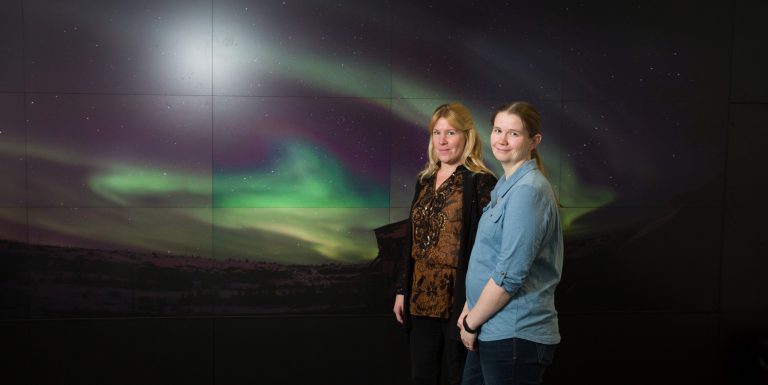
“The aurora borealis is a fickle phenomenon. A week can pass without a flicker…then bang! The northern lights come on like a celestial lava lamp.” – Nigel Tisdall, Northern Lights: Light at the end of the Tundra
The aurora borealis (more commonly known as the northern lights) is recognised as one of the most stunning phenomena of the natural world. This hair-raising light show illuminates the sky with a rich palette of greens, pinks, reds, yellows, violets and blues to create one of the most vibrant and mysterious enigmas known to man.
According to the Service Aurora, the display is provoked by a series of collisions between electrically-charged particles set free from the sun. These electrified atoms break through the Earth’s atmosphere, clashing with volatile gases such as nitrogen and oxygen and exploding into light. When the display is seen around the magnetic poles of the Southern Hemisphere it’s known as the ‘aurora austalis,’ but when it’s sighted in the region of the Northern Hemisphere it’s known as the ‘aurora borealis.’

Image via Unsplash
Earlier this year, The Telegraph reported increased sightings of the northern lights sparked by heightened levels of solar activity. The article reports that as far south as Oxfordshire in the United Kingdom, the sky was embellished with tones of purples, greens and blues – a spectacle that’s rarely seen so far south of the North Pole. In countries such as Canada, for example, the aurora glows regularly across the night sky, and though it is a much-loved, beautiful manifestation, it brings with it a number of problems you may not previously have known…
“Space research is deepening our understanding of atmospheric phenomena like the space weather dynamics that create aurora borealis,” the University of Calgary notes. “This breathtaking light show belies the epic forces at the heart of space storms that send radiation, solar winds, and magnetic fields into swirling dances around Earth – while disturbing our technologies.
“These space weather disturbances are a bigger problem for Canada than for other countries, because of our northerly location,” the institution adds. “On top of our global reliance on space technologies, near-Earth space research is becoming increasingly important.”
The University of Calgary (UCalgary) is known as a world leader in the development and application of new Earth-space technologies. As a theme that crosses the boundaries of all its faculties and disciplines, its specialized programs incorporate research strengths to create brand new technologies, established to improve global communication networks and environmental monitoring.
Due to its status as a global ground-breaker in space research, UCalgary has received a healthy investment of CAD$1.4million from the Canadian Space Agency (CSA) for the funding of four pioneering projects. These projects aim to allow researchers to feed the public’s understanding of these magical energetic systems, and help maintain UCalgary’s dominant status as leader in this kind of research.

Emma Spanswick. Image courtesy of UCalgary
“The latest CSA support enables [UCalgary] researchers, focused on new Earth-space discovery and development, to continue to lead internationally,” says Ed McCauley, the institution’s Vice-President of Research.
“This research is resulting in better sensor and webs for environmental monitoring and Global Navigation Satellite Systems as part of this key research priority,” he concludes.
A study conducted by space physicist Emma Spanswick and geometrics engineer Susan Skone of the Schulich School of Engineering, will investigate the truth behind the aroura, and how its glowing lights meddle with the functions of Global Positioning Systems (GPS).
“The ionosphere is a dynamic part of the Earth’s upper atmosphere. It’s not predictable and is like a dumping ground for high-energy particles coming from the larger space environment,” Spanswick describes.
This type of research produces far-reaching global benefits for things so ingrained in our daily routines that we consistently take them for granted. A solar storm of truly epic proportions – think the aurora, but in a much more apocalyptic form – would shake life up in ways that humanity can barely fathom. For instance, just a few of the ramifications would be that the internet would crash and cause carnage in cosmopolitan hubs, pilots would be unable to reach traffic control, and transport systems would grind to a halt.

Image via Unsplash
To describe this issue in its simplest form, disruption to our satellites has the potential to stop modern life as we know it. It would bring about a universal disaster that would unravel years of progress. The research carried out by Spanswick, Skone, and their teams at innovative institutions like UCalgary is crucial to development because it helps us understand the complexities of the high-tech world we’ve built.
“Our end goal is to be able to use…data to provide an estimate of the likelihood of GPS signal interference,” Spanswick explains, reminding us that what starts as research into one of nature’s brightest wonders could end with the prevention of a planetoid catastrophe – at it all begins at UCalgary.
Follow UCalgary on Facebook, Twitter, YouTube, Instagram and LinkedIn
Feature image courtesy of UCalgary
Like this? Then you’ll love these…
Top 3 reasons to study in Canada
Why Liverpool University is monitoring volcanoes around the world







